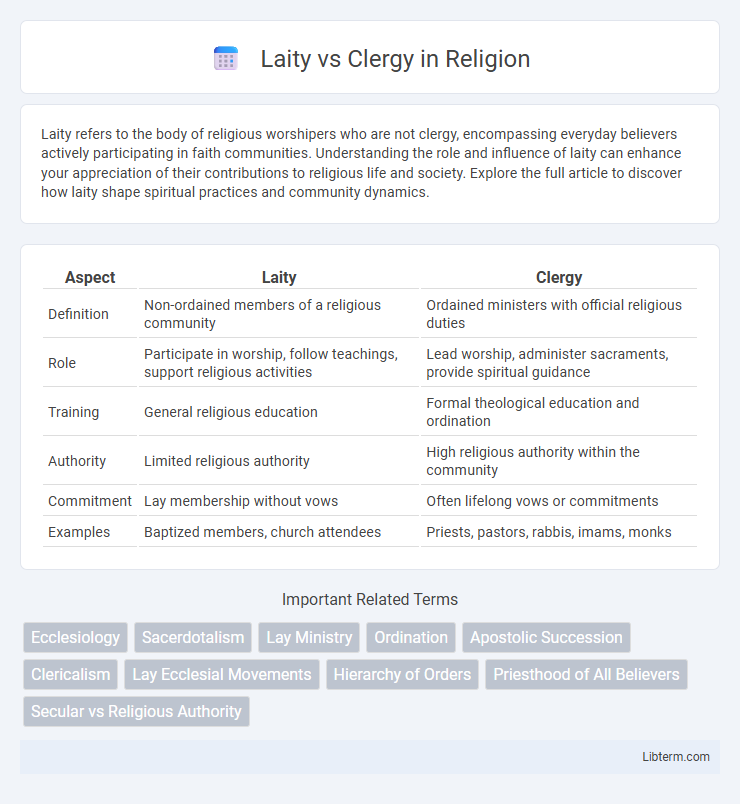Laity refers to the body of religious worshipers who are not clergy, encompassing everyday believers actively participating in faith communities. Understanding the role and influence of laity can enhance your appreciation of their contributions to religious life and society. Explore the full article to discover how laity shape spiritual practices and community dynamics.
Table of Comparison
| Aspect | Laity | Clergy |
|---|---|---|
| Definition | Non-ordained members of a religious community | Ordained ministers with official religious duties |
| Role | Participate in worship, follow teachings, support religious activities | Lead worship, administer sacraments, provide spiritual guidance |
| Training | General religious education | Formal theological education and ordination |
| Authority | Limited religious authority | High religious authority within the community |
| Commitment | Lay membership without vows | Often lifelong vows or commitments |
| Examples | Baptized members, church attendees | Priests, pastors, rabbis, imams, monks |
Understanding the Terms: Laity and Clergy
Laity refers to non-ordained members of a religious community who participate in its worship and mission without holding official ecclesiastical authority. Clergy consists of ordained individuals, such as priests, ministers, or pastors, who have been formally consecrated to lead religious services and perform sacraments. Understanding the distinction between laity and clergy is essential for grasping the organizational structure and roles within many religious traditions.
Historical Origins of the Laity-Clergy Distinction
The laity-clergy distinction originated in early Christianity as the church formalized roles to preserve doctrinal purity and administrative order. Historical records from the Roman Empire era indicate that clergy were designated as ordained leaders responsible for sacraments and liturgical functions, while the laity comprised baptized believers participating in communal worship without clerical authority. This separation evolved through the Middle Ages, cementing ecclesiastical hierarchies and defining social roles within Christian communities.
Roles and Responsibilities: Laity vs Clergy
The laity participates actively in the mission of the Church through worship, evangelization, and community service, often engaging in ministries such as catechesis, charitable activities, and lay leadership roles. The clergy, including priests, bishops, and deacons, are entrusted with sacramental duties, doctrinal teaching, and pastoral governance, acting as spiritual leaders and mediators between God and the congregation. Distinct from the laity, the clergy maintains a formal vocation with specific liturgical responsibilities and canonical authority within the Church hierarchy.
Theological Foundations for Clergy and Laity
Theological foundations distinguish clergy and laity primarily through sacramental roles and ministerial functions grounded in Scripture and Church tradition. Clergy, ordained through sacrament, serve as mediators for divine grace and administer sacred rites, reflecting Christ's priestly mission. Laity participate in Christ's mission by living out baptismal priesthood, engaging in evangelization and sanctifying the temporal order.
Power Dynamics: Authority in the Church
The power dynamics between laity and clergy in the church revolve around the exclusive authority clergy hold in sacramental and doctrinal matters, often positioning them as spiritual leaders and decision-makers. Laity, while integral to the church community, typically exercise influence through participation and support rather than formal ecclesiastical authority. This hierarchy emphasizes the clergy's role in interpreting religious teachings, enacting church discipline, and guiding congregational worship.
Participation in Worship and Sacraments
Laity actively participate in worship through singing, prayers, and communal responses, while clergy lead the liturgy and administer sacraments such as baptism and Eucharist. The clergy holds the exclusive authority to consecrate the sacraments, establishing a distinct role in sacramental rites. Laity engage in reception and personal devotion, contributing to the spiritual life of the congregation without performing sacramental functions.
Education and Formation of Laity and Clergy
Education and formation of laity center on catechetical instruction, parish involvement, and lay ministry training to empower active participation in church life and evangelization. Clergy undergo seminary education, including theological studies, pastoral training, and spiritual formation, to prepare for sacramental duties and leadership roles within the church hierarchy. Both laity and clergy formation emphasize ongoing education, but clergy formation requires formal ordination and specialized doctrinal expertise.
Modern Challenges in Laity-Clergy Relationships
Modern challenges in laity-clergy relationships include navigating shifting authority dynamics as lay members seek greater participation in church governance and decision-making processes. The rise of social media and digital communication platforms amplifies diverse voices, sometimes causing tension over theological interpretations and pastoral roles. Addressing these challenges requires fostering collaborative dialogue that respects both clerical expertise and lay perspectives to maintain church unity and relevance.
Prominent Debates: Lay Involvement in Leadership
Prominent debates surrounding lay involvement in leadership often emphasize the balance of authority between laity and clergy within church governance. Discussions center on whether laypersons should hold decision-making power traditionally reserved for ordained clergy, impacting organizational dynamics and spiritual guidance. This debate continues to influence denominational policies and the evolving roles of non-ordained members in ecclesiastical leadership.
The Future of Laity and Clergy Collaboration
The future of laity and clergy collaboration hinges on shared leadership models that emphasize co-responsibility in church governance and ministry, fostering a more inclusive and empowered faith community. Technological advancements and virtual platforms are expanding opportunities for laity participation, enabling broader engagement in theological education, pastoral care, and decision-making processes. Emerging trends suggest a shift towards mutual recognition of spiritual gifts, enhancing collaborative efforts to address contemporary social issues and church growth strategies.
Laity Infographic

 libterm.com
libterm.com